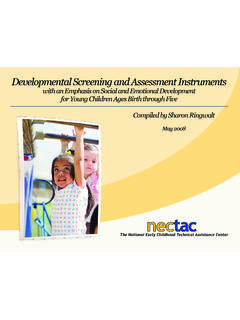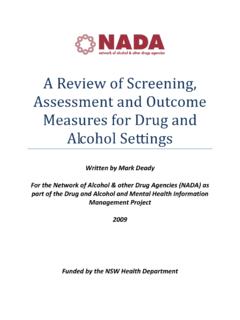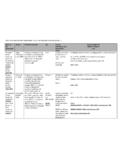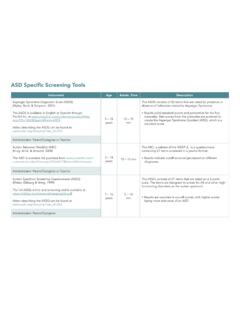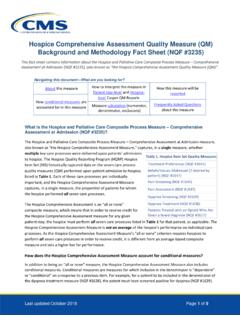Transcription of GUIDELINE FOR DRUG COURTS ON SCREENING AND …
1 GUIDELINE FOR DRUG COURTS . ON SCREENING AND assessment . Roger H. Peters1 and Elizabeth Peyton2. Prepared for the American University, Justice Programs Office, in association with the Department of Justice, Office of Justice Programs, Drug COURTS Program Office May 1998. 1 AssociateProfessor, Department of Mental Health Law and Policy, the Louis de la Parte Florida Mental Health Institute, University of South Florida. 2 Executive Director, National TASC Treatment Accountability for Safer Communities. i ii Acknowledgments The authors express sincere appreciation to the following persons who volunteered their valuable time and expertise to the development of this document: Hon.
2 William G. Meyer Jody Forman Denver Drug Court Project Charlottesville, VA. Denver, CO. Marc Pearce Hon. Richard S. Gebelein National Association of Drug Delaware Superior Court Court Professionals Wilmington, DE. Alexandria, VA. Martin O. Conoley Joseph Carloni Santa Barbara County Probation Pathway Treatment Services Santa Barbara, CA Pensacola, FL. Ed Brekke Valerie Moore Los Angeles Superior Court IN ACT, Inc. Los Angeles, CA Portland, OR. Caroline Cooper The American University Washington, DC. iii iv Table of Contents FOREWORD .. 1. INTRODUCTION .. 3. What are the differences between SCREENING and assessment ? .. 3. Goals of SCREENING and assessment .
3 4. Characteristics of SCREENING and assessment .. 5. What factors help to shape the drug court SCREENING and assessment process? .. 6. Importance of drug court SCREENING and assessment .. 6. Performance benchmarks for drug court SCREENING and 8. DRUG COURT SCREENING .. 9. Who should conduct SCREENING ? .. 9. Steps in conducting SCREENING .. 9. What information should be included in a drug court SCREENING ? .. 11. Core SCREENING elements .. 11. SCREENING issues for women .. 12. SCREENING for mental health problems .. 13. SCREENING for 14. SCREENING for motivation and readiness for treatment .. 14. Use of self-report information .. 15. What instruments should be used in drug court SCREENING ?
4 16. Key issues in selecting SCREENING instruments .. 17. Substance abuse SCREENING instruments .. 17. v Mental health SCREENING instruments .. 18. Motivational SCREENING 18. What SCREENING information is most relevant to the court?.. 18. DRUG COURT assessment .. 21. When should drug court assessment be conducted? .. 21. Who should conduct assessment ?.. 21. What information should be included in a drug court assessment ? .. 22. Areas for detailed assessment .. 22. What instruments are available for assessment of participants in drug court programs? .. 24. What assessment information is most relevant to the court? .. 25. Obtaining release of confidential information.
5 25. SUMMARY .. 27. REFERENCES .. 29. OTHER RELATED RESOURCE MATERIALS .. 33. APPENDIX A: Selected instruments .. 35. APPENDIX B: Availability and Cost of SCREENING instruments .. 43. APPENDIX C: Addiction Severity Index .. 47. APPENDIX D: Single State Alcohol and Drug Agency Directors .. 63. vi Foreword This GUIDELINE is written to help drug COURTS develop effective policies, procedures, and techniques for SCREENING and assessing treatment needs of drug court participants. This document describes the principles and methods of SCREENING and assessment of adult drug court participants, and gives drug COURTS specific tools and information to establish and sustain SCREENING and assessment processes.
6 While much of the information here will be helpful for juvenile drug COURTS , specific guidance for juveniles should be obtained from other Several key principles and strategies for conducting effective SCREENING and assessment described in the GUIDELINE are derived from experiences of existing drug COURTS and other community-based substance abuse treatment programs for offenders. Several useful guidelines and monographs on SCREENING and assessment for criminal justice and non- criminal justice populations are included as references in the back of this GUIDELINE . Readers interested in additional information on this subject are encouraged to use these resources.
7 This publication is one of several technical assistance monographs for drug COURTS that the Department of Justice, Office of Justice Programs, has developed. This document presents general issues related to SCREENING and assessing drug court clients, describes the processes and elements of SCREENING and assessment in detail, summarizes key issues for drug COURTS to consider as they screen and assess partici- pants, and provides resource materials for those seeking additional information. 3 Seefor example Center for Substance Abuse Treatment (1993) SCREENING and assessment of Alcohol- and Other Drug-Abusing Adolescents. Treatment Improvement Protocol Series, #3.
8 Rockville, MD. 1. 2. Introduction What Are the Differences Between that would interfere with an individual's SCREENING and assessment ? involvement in treatment. Once the initial SCREENING decision is made, assessment helps SCREENING and assessment are often described to determine which types of services should as discrete events completed by using specific be provided, and in what sequence these ser- instruments . In fact, SCREENING and assessment vices should be provided. Diagnosis is part are part of an ongoing decision-making process of the more detailed assessment process, and that examines information on substance abuse summarizes the pattern of current symptoms and criminal history, motivation for treatment, and functional impairment for several types of disorders ( , substance use disorders, mental educational and employment factors, and other health disorders).
9 4. problem areas. Information gathered during SCREENING and assessment is used to develop a Several different drug court professionals treatment plan that will be updated over time such as prosecutors, public defenders, treatment to reflect participant progress, significant life staff, probation officers, court administrators, events ( , relapse, changes in living arrange- and pretrial services/TASC (Treatment Account- ments), and changing service needs. While use ability for Safer Communities) staff, are often of structured instruments is a core element of involved in A nationwide survey SCREENING and assessment , this activity must of drug court programs (Cooper, 1997) found be supplemented by an individual interview, that, for pretrial drug court programs, initial review of archival materials ( , criminal justice system SCREENING is usually conducted justice records, treatment records, drug test by the prosecutor and either pretrial services or results, employment records), clinical other drug court staff.
10 Justice system SCREENING observation, and discussions with probation is usually conducted by the prosecutor and officers, family members, or significant others. probation officer in post-conviction programs. In most drug COURTS , the judge and prosecutor Although part of a continuous process, screen- provide the final review of program eligibility, ing determines eligibility and appropriateness although the defense counsel is also involved in for participation in drug court, while assessment identifying and SCREENING eligible cases. Once helps to identify specific types of services and justice system SCREENING is completed, a clinical determine the intensity of treatment needed.











